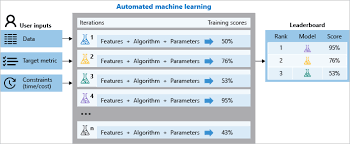How AutoML Can Save Time and Money for Data Scientists
 Barry Ugochukwu
Barry UgochukwuTable of contents

Data science is one of the most sought-after fields in the 21st century, as it enables businesses to gain insights from data and make better decisions. However, data science is also a complex and time-consuming process that requires a lot of expertise and resources. Data scientists have to deal with various challenges such as:
- Finding, cleaning, and preparing data for analysis
- Choosing the right machine learning algorithms and hyperparameters
- Evaluating and comparing different models
- Deploying and maintaining models in production
These tasks can take weeks or months to complete, depending on the size and complexity of the data and the problem. Moreover, data scientists often have to repeat these tasks for different datasets or problems, which can lead to inefficiency and redundancy.
This is where automated machine learning (AutoML) comes in. AutoML is the process of automating the time-consuming, iterative tasks of machine learning model development. It allows data scientists, analysts, and developers to build ML models with high scale, efficiency, and productivity all while sustaining model quality.
What is AutoML?
AutoML is based on a breakthrough from Microsoft Research division that aims to make machine learning more accessible, improve efficiency of machine learning systems, and accelerate research and AI application development.
AutoML works by creating a number of pipelines in parallel that try different algorithms and parameters for you. The service iterates through ML algorithms paired with feature selections, where each iteration produces a model with a training score. The better the score for the metric you want to optimize for, the better the model is considered to "fit" your data. It will stop once it hits the exit criteria defined in the experiment.
According to Microsoft, AutoML lets you automate your ML training experiments with these steps:
Define the ML problem you want to solve: choose from classification, forecasting, regression, computer vision or natural language processing (NLP).
Pick your preferred experience: code-first or no-code studio web experience: If you like coding, you can use Azure Machine Learning SDKv2 or Azure Machine Learning CLIv2. If you don’t want to code much or at all, you can use Google Cloud AutoML web interface at https://cloud.google.com/automl/.
Provide the labeled training data source: You have many options to bring your data to AutoML.
Set up the automated machine learning parameters that control how many iterations over different models, hyperparameter settings, advanced preprocessing/featurization, and what metrics to use to determine the best model.
Start the training job.
Check the results: You can also look at the logged job information, which contains metrics collected during the joe job


While model building is automated, you can also learn how important or relevant features are to the generated models.
What are the benefits of AutoML?
AutoML can offer many benefits for data scientists and their organizations, such as:
Speedier time to value: AutoML can significantly reduce the time needed to develop and deploy machine learning models, from weeks or months to days or hours. This can help organizations achieve faster return on investment and improve their competitive edge.
Greater acceleration at scale: AutoML can handle large and complex datasets with ease, as well as multiple problems or domains. This can help organizations scale their machine learning capabilities and applications without compromising on quality or performance.
Realizing operational excellence: AutoML can automate the tedious and repetitive tasks of machine learning development, such as data cleaning, feature engineering, algorithm selection, hyperparameter tuning, model evaluation, and deployment. This can free up data scientists’ time and resources for more creative and strategic work.
Democratizing AI: AutoML can lower the barrier of entry for machine learning by providing a user-friendly interface that does not require extensive coding or ML expertise. This can enable more people in an organization to leverage AI for their business needs and empower them with data-driven insights.
How to use AutoML?
There are many tools and platforms that offer AutoML solutions for different use cases and scenarios. Some of the popular ones are:
Google Cloud AutoML: A suite of products that enable users to train high-quality custom machine learning models with minimal effort and ML expertise. It supports structured data (AutoML Tables), image classification (AutoML Vision), natural language processing (AutoML Natural Language), video analysis (AutoML Video), translation (AutoML Translation), etc.
Azure Machine Learning: A unified platform that helps users build, deploy, and scale more AI models. It supports classification, regression, forecasting, computer vision (including object detection), natural language processing (including text classification), etc.
H2O Driverless AI: An enterprise-ready platform that automates some of the most difficult data science tasks such as feature engineering, model validation,model validation, model explainability, and model deployment.
Google Cloud AutoML: A suite of products that enable users to train high-quality custom machine learning models with minimal effort and ML expertise. It supports structured data (AutoML Tables), image classification (AutoML Vision), natural language processing (AutoML Natural Language), video analysis (AutoML Video), translation (AutoML Translation), etc.
Azure Machine Learning: A unified platform that helps users build, deploy, and scale more AI models. It supports classification, regression, forecasting, computer vision (including object detection), natural language processing (including text classification), etc.
AutoGluon: An open-source AutoML framework that automates machine learning tasks such as data preprocessing, feature engineering, neural architecture search, hyperparameter tuning, and model ensembling.
AutoML is a powerful technology that can help data scientists save time and money by automating the tedious and complex tasks of machine learning development. It can also enable more people in an organization to leverage AI for their business needs and empower them with data-driven insights. However, AutoML is not a magic bullet that can solve all problems without human intervention. Data scientists still need to understand the problem domain, define the objectives and metrics, interpret the results and explainability reports, and monitor the models in production. AutoML is a tool that can augment human intelligence, not replace it.
If you are interested in learning more about AutoML or trying it out for yourself,you can check out some of the tutorials and resources listed below:
Tutorial: Train a classification model with no-code AutoML in Azure Machine Learning
AutoML beginner's guide | Vertex | Google Cloud
What is automated ML? AutoML - Azure Machine Learning
I hope you enjoyed this article and learned something new about AutoML. Thank you for reading! 😊
Subscribe to my newsletter
Read articles from Barry Ugochukwu directly inside your inbox. Subscribe to the newsletter, and don't miss out.
Written by

Barry Ugochukwu
Barry Ugochukwu
I'm a data scientist and a technical content writer who loves to explore and share insights from data. I have experience working with various tools and technologies such as Python, Power BI, TensorFlow, PyTorch, and more. I also enjoy writing about data science topics such as artificial intelligence, deep learning, natural language processing, computer vision, and more. When I'm not writing or doing data science stuff, I like to play chess🏁🏁🏁 read books📚📚📚 or discuss about space🌠🌠🌠 If you want to learn more about me or my work, Check out my Github profile Read my blog Follow me on Twitter Contact me on barryugo1000@gmail.com Thank you for visiting and I hope to hear from you soon!